2017 PEUGEOT 4008 warning light
[x] Cancel search: warning lightPage 4 of 368

.
.
4008_en_Chap00a_sommaire_ed01-2016
Instrument panel 12
Warning and indicator lamps
1
3
Instrument panel screen
1
9
tr
ip computer
3
2
Distance recorder
3
2
tr
ip distance recorder
3
2
Service indicator
3
3
Adjusting vehicle settings
3
7
Audio- CD system screen
4
4
Audio- CD system touch screen
4
6
Audio-
te
lematic system
touch screen
4
8
Lighting dimmer
5
1Remote control key
5
2
"Keyless e
n
try and Starting"
system
5
6
Doors 62
Boot
6
3
Alarm
65
el
ectric windows
6
8
Panoramic sunroof
7
0
Front seats 7 1
Rear seats
7
4
Mirrors
76
Steering wheel adjustment
7
8
Ventilation
7
9
Manual heating / air conditioning
8
1
Automatic air conditioning
8
3
Front demist - defrost
87
R
ear screen demist - defrost
88
Interior fittings
8
9
Boot fittings
9
5Driving recommendations
9
7
Starting - switching off the engine with the key 98
S
tarting - switching off the engine with the Keyless
e
n
try and Starting system
9
9
Parking brake
1
02
Manual gearbox
1
03
ge
ar shift indicator
1
04
CV
t
gearbox
1
05
Hill start assist
1
10
Stop & Start (Auto Stop &
g
o
) system
1
11
Under-inflation detection
1
14
Four wheel drive system
1
18
Cruise control
1
20
Parking sensors
1
23
Reversing camera
1
26
Lighting controls
1
27
Daytime running lamps
1
30
Automatic illumination of headlamps
1
30
Manual guide-me-home lighting
1
31
Welcome lighting
1
32
Headlamp adjustment
1
33
Wiper controls
1
34
Automatic rain sensitive wipers
1
36
Courtesy lamps
1
38
Boot lamp
1
40
Panoramic roof lighting
1
40
Over view
e
co-driving
Instruments Access
ea
se of use and comfort Driving
Lighting and visibility
Contents
Page 18 of 368

16
Operation indicator lamps
If one of the following indicator lamps comes on, this confirms that the corresponding system has come into operation.
It may be accompanied by an audible signal and a message in the instrument panel screen.Warning /indicator lampis on Cause Action / Observations
Left-hand
direction
indicator flashing with audible
warning.
th
e lighting stalk has been pressed
downwards. If this indicator lamp flashes abnormally quickly, this
could indicate that the bulb of one of the direction
indicators has blown. Change the bulb or contact a
P
e
uge
Ot
dealer or a qualified workshop.
Right-hand
direction
indicator flashing with audible
warning.
th
e lighting stalk has been pushed
upwards. If this indicator lamp flashes abnormally quickly, this
could indicate that the bulb of one of the direction
indicators has blown. Change the bulb or contact a
P
e
uge
Ot
dealer or a qualified workshop.
Sidelamps or
dipped beam
headlamps fixed.
th
e sidelamps or dipped beam
headlamps are on.
Main beam
headlamps fixed.
th
e lighting stalk is pulled towards
you. Pull the stalk to return to dipped beam headlamps.
Front foglamps fixed.
th
e front foglamps are switched on
using the ring on the lighting control
stalk.
tu
rn the ring on the lighting control stalk rear ward
once to switch off the front foglamps.
Rear foglamp sfixed.
th
e rear foglamps are switched on.
tu
rn the ring on the stalk rear ward to switch off the
rear foglamps.
Instruments
Page 19 of 368

17
4008_en_Chap01_Instruments-de-bord_ed01-2016
Warning/indicator lampis on Cause Action / Observations
Cruise control fixed.
th
is comes on when the cruise
control has been activated. Press the "ON/OFF" button to activate/deactivate the
cruise control.
Active stability
control and
traction control
(ASC/TCL) flashing.
Operation of the ASC/
tC
L systems.
th
e systems optimise traction and improve the
directional stability of the vehicle.
Adapt your driving and moderate your speed.
fixed. Fault in the ASC/
tC
L systems. Have it checked by a P
e
uge
Ot
dealer or a qualified
workshop.
Stop & Star t
(Auto Stop & Go)
system fixed.
When the vehicle stops (red lights,
traffic jams, etc.), the Stop & Start
(AS&
g) s
ystem has put the engine
into S
tO
P mode.
th
e warning lamp goes off and the engine restarts
automatically in S
tA
R
t
mode, as soon as you want to
move off.
flashing for a few
seconds, then goes
of f. S
tO
P mode is temporarily
unavailable. For more information on the Stop & Star t (Auto
Stop & Go) system and in particular the special
cases with S
tO
P mode and S
tA
R
t
mode, refer to the
corresponding section.
Diesel engine
pre-heating
fixed.
the
engine is cold and:
-
t
he ignition switch is at the
ON
position, or
-
the START/STOP starting button
has been pressed (ignition on). With key starting, wait until the warning lamp has gone
off before starting.
With the Keyless
e
n
try and Starting system, the engine
will only start after the warning lamp has gone off.
th
e duration for which the warning lamp is on is
determined by the climatic conditions (up to 30 seconds
in severe weather).
If the engine does not start, switch the ignition off and
then on again and wait again until the warning lamp
goes off, then start the engine.
1
Instruments
Page 22 of 368
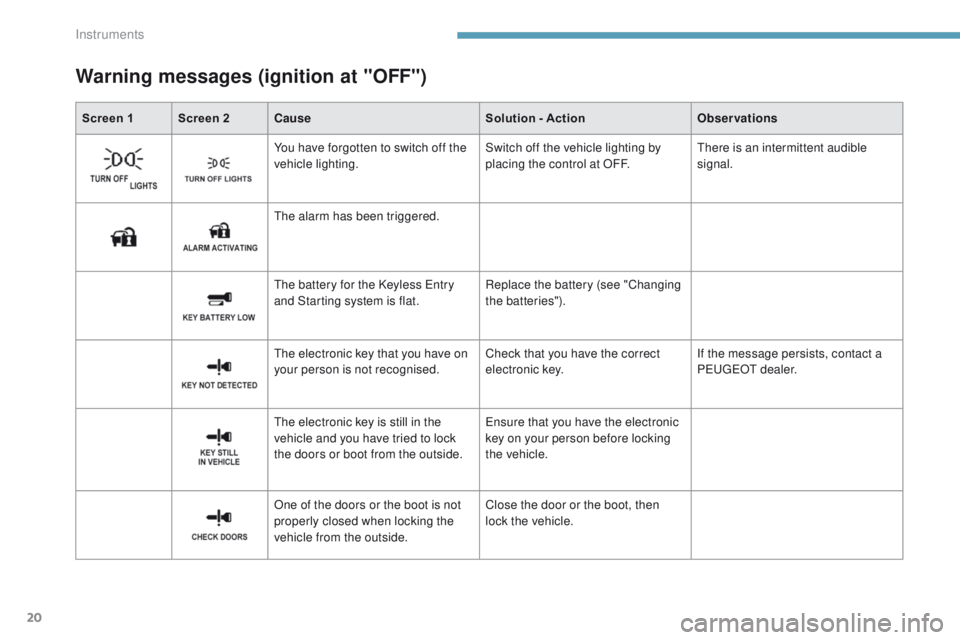
20
Warning messages (ignition at "OFF")
Screen 1 Screen 2Cause Solution - ActionObservations
You have forgotten to switch off the
vehicle lighting. Switch off the vehicle lighting by
placing the control at OFF.
ther
e is an intermittent audible
signal.
th
e alarm has been triggered.
th
e battery for the Keyless e
n
try
and Starting system is flat. Replace the battery (see "Changing
the batteries").
th
e electronic key that you have on
your person is not recognised. Check that you have the correct
electronic key.If the message persists, contact a
P
e
uge
Ot d
ealer.
th
e electronic key is still in the
vehicle and you have tried to lock
the doors or boot from the outside.
en
sure that you have the electronic
key on your person before locking
the vehicle.
One of the doors or the boot is not
properly closed when locking the
vehicle from the outside. Close the door or the boot, then
lock the vehicle.
Instruments
Page 102 of 368
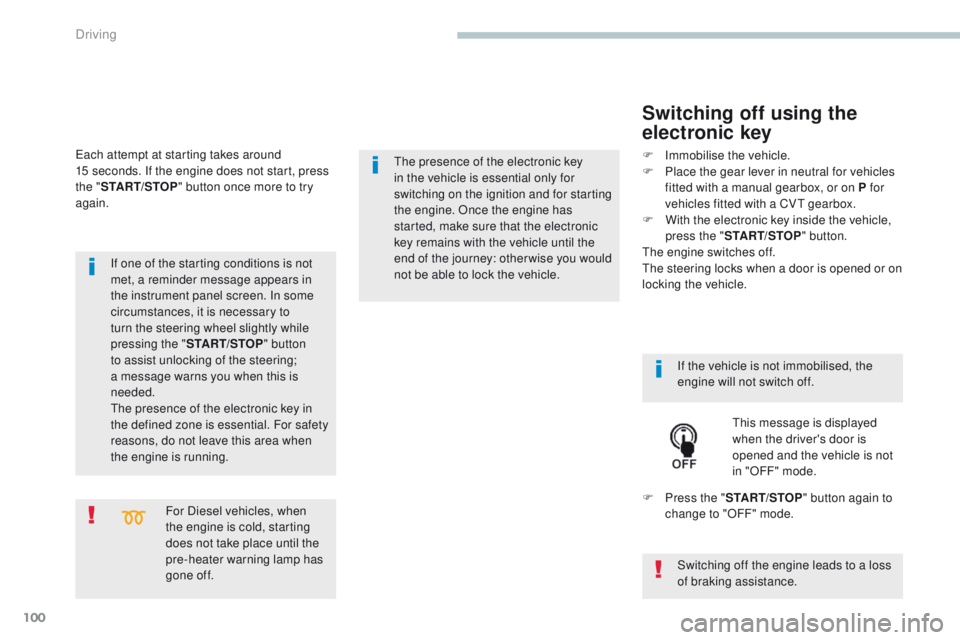
100
4008_en_Chap04_conduite_ed01-2016
For Diesel vehicles, when
the engine is cold, starting
does not take place until the
pre-heater warning lamp has
gone of f.
If one of the starting conditions is not
met, a reminder message appears in
the instrument panel screen. In some
circumstances, it is necessary to
turn the steering wheel slightly while
pressing the "
START/STOP " button
to assist unlocking of the steering;
a message warns you when this is
needed.
th
e presence of the electronic key in
the defined zone is essential. For safety
reasons, do not leave this area when
the engine is running.
Switching off using the
electronic key
If the vehicle is not immobilised, the
engine will not switch off.
th
is message is displayed
when the driver's door is
opened and the vehicle is not
in "OFF" mode.
F
P
ress the " START/STOP " button again to
change to "OFF" mode.
F
Imm
obilise the vehicle.
F
P
lace the gear lever in neutral for vehicles
fitted with a manual gearbox, or on P for
vehicles fitted with a CV
t
gearbox.
F
W
ith the electronic key inside the vehicle,
press the " START/STOP " button.
the
engine switches off.
th
e steering locks when a door is opened or on
locking the vehicle.
ea
ch attempt at starting takes around
15
seconds. If the engine does not start, press
the " START/STOP " button once more to try
again.
the presence of the electronic key
in the vehicle is essential only for
switching on the ignition and for starting
the engine. Once the engine has
started, make sure that the electronic
key remains with the vehicle until the
end of the journey: otherwise you would
not be able to lock the vehicle.
Switching off the engine leads to a loss
of braking assistance.
Driving
Page 113 of 368
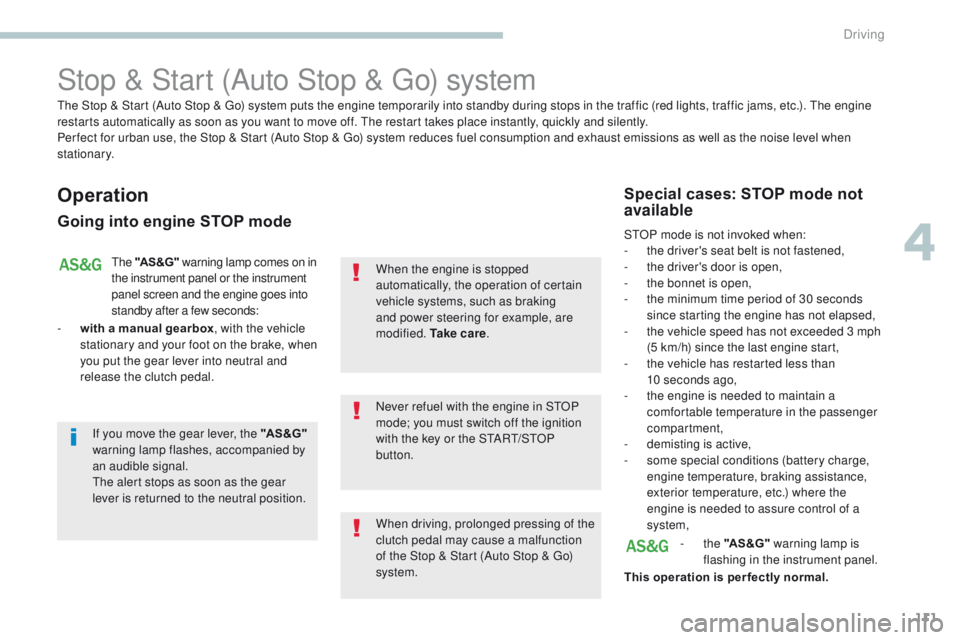
111
4008_en_Chap04_conduite_ed01-2016
Stop & Start (Auto Stop & go) system
Operation
Going into engine STOP mode
the "AS &G" warning lamp comes on in
the instrument panel or the instrument
panel screen and the engine goes into
standby after a few seconds:
-
w
ith a manual gearbox , with the vehicle
stationary and your foot on the brake, when
you put the gear lever into neutral and
release the clutch pedal.
Never refuel with the engine in S
tO
P
mode; you must switch off the ignition
with the key or the S
tA
R
t/
S
tO
P
button. When the engine is stopped
automatically, the operation of certain
vehicle systems, such as braking
and power steering for example, are
modified. Ta k e c a r e .
Special cases: STOP mode not
available
StOP mode is not invoked when:
-
t he driver's seat belt is not fastened,
-
t
he driver's door is open,
-
t
he bonnet is open,
-
t
he minimum time period of 30 seconds
since starting the engine has not elapsed,
-
t
he vehicle speed has not exceeded 3 mph
(5 km/h) since the last engine start,
-
t
he vehicle has restarted less than
10
seconds ago,
-
t
he engine is needed to maintain a
comfortable temperature in the passenger
compartment,
-
d
emisting is active,
-
s
ome special conditions (battery charge,
engine temperature, braking assistance,
exterior temperature, etc.) where the
engine is needed to assure control of a
system,
-
the "AS &G" warning lamp is
flashing in the instrument panel.
This operation is per fectly normal.
th
e Stop & Start (Auto Stop &
g
o
) system puts the engine temporarily into standby during stops in the traffic (red lights, traffic jams, etc.). t
h
e engine
restarts automatically as soon as you want to move off.
t
h
e restart takes place instantly, quickly and silently.
Per fect for urban use, the Stop & Start (Auto Stop &
g
o
) system reduces fuel consumption and exhaust emissions as well as the noise level when
stationary.
If you move the gear lever, the "AS &G"
warning lamp flashes, accompanied by
an audible signal.
th
e alert stops as soon as the gear
lever is returned to the neutral position.
When driving, prolonged pressing of the
clutch pedal may cause a malfunction
of the Stop & Start (Auto Stop &
g
o
)
system.
4
Driving
Page 144 of 368
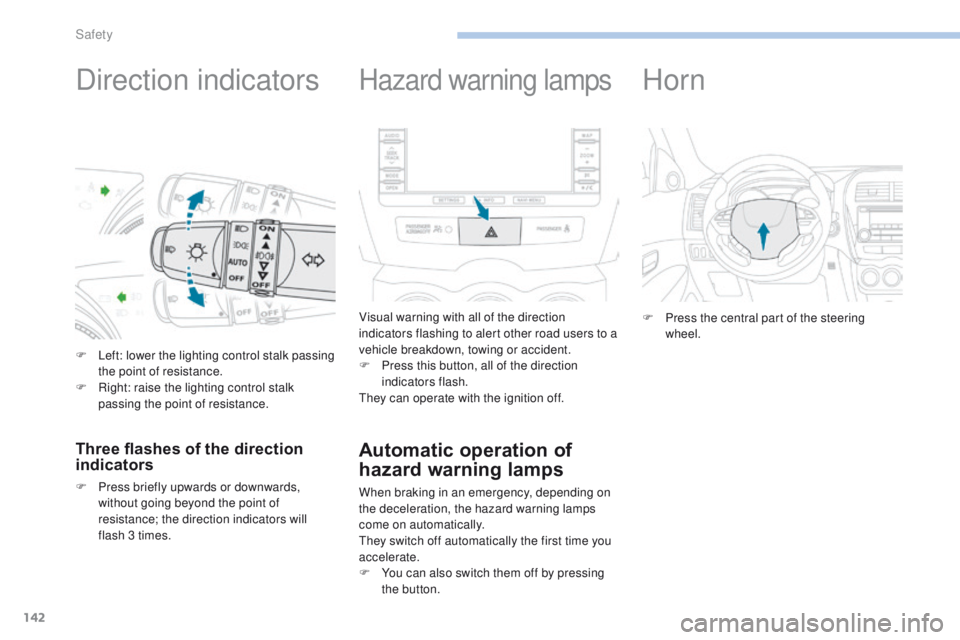
142
4008_en_Chap06_securite_ed01-2016
Direction indicators
F Left: lower the lighting control stalk passing the point of resistance.
F
R
ight: raise the lighting control stalk
passing the point of resistance.
Three flashes of the direction
indicators
F Press briefly upwards or downwards, without going beyond the point of
resistance; the direction indicators will
flash 3 times.
Hazard warning lamps
Visual warning with all of the direction
indicators flashing to alert other road users to a
vehicle breakdown, towing or accident.
F
P
ress this button, all of the direction
indicators flash.
th
ey can operate with the ignition off.
Automatic operation of
hazard warning lamps
When braking in an emergency, depending on
the deceleration, the hazard warning lamps
come on automatically.
th
ey switch off automatically the first time you
accelerate.
F
Y
ou can also switch them off by pressing
the button.
Horn
F Press the central part of the steering wheel.
Safety
Page 145 of 368
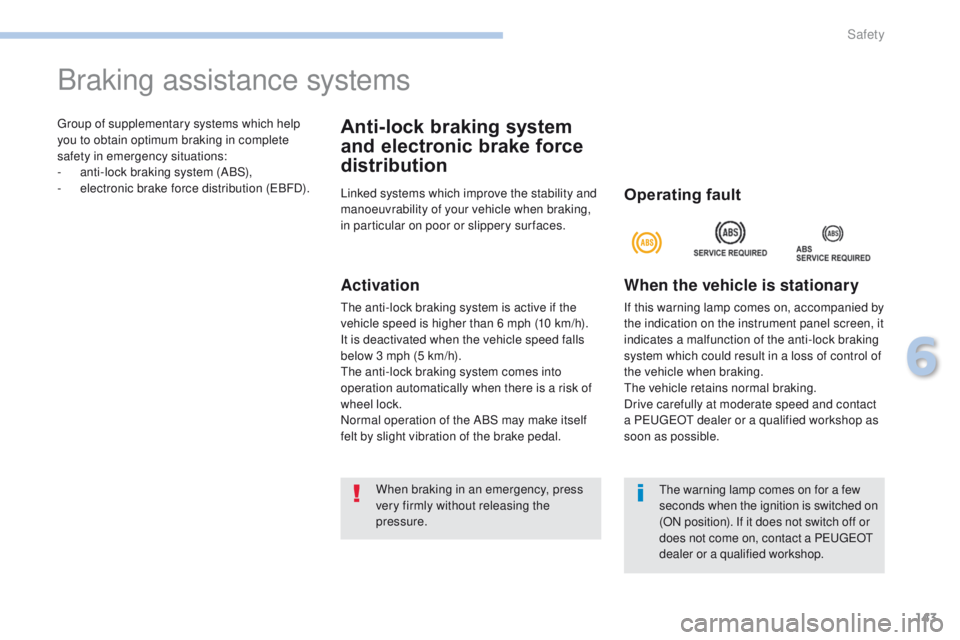
143
4008_en_Chap06_securite_ed01-2016
group of supplementary systems which help
you to obtain optimum braking in complete
safety in emergency situations:
-
a
nti-lock braking system (ABS),
-
e
lectronic brake force distribution (
eB
FD).
Braking assistance systems
Anti-lock braking system
and electronic brake force
distribution
Linked systems which improve the stability and
manoeuvrability of your vehicle when braking,
in particular on poor or slippery sur faces.
Activation
the anti-lock braking system is active if the
vehicle speed is higher than 6 mph (10 km/h).
It is deactivated when the vehicle speed falls
below 3
mph (5 km/h).
th
e anti-lock braking system comes into
operation automatically when there is a risk of
wheel lock.
Normal operation of the ABS may make itself
felt by slight vibration of the brake pedal.
Operating fault
When the vehicle is stationary
If this warning lamp comes on, accompanied by
the indication on the instrument panel screen, it
indicates a malfunction of the anti-lock braking
system which could result in a loss of control of
the vehicle when braking.
th
e vehicle retains normal braking.
Drive carefully at moderate speed and contact
a P
e
uge
Ot
dealer or a qualified workshop as
soon as possible.
When braking in an emergency, press
very firmly without releasing the
pressure.
th
e warning lamp comes on for a few
seconds when the ignition is switched on
(ON position). If it does not switch off or
does not come on, contact a P
e
uge
Ot
d
ealer or a qualified workshop.
6
Safety